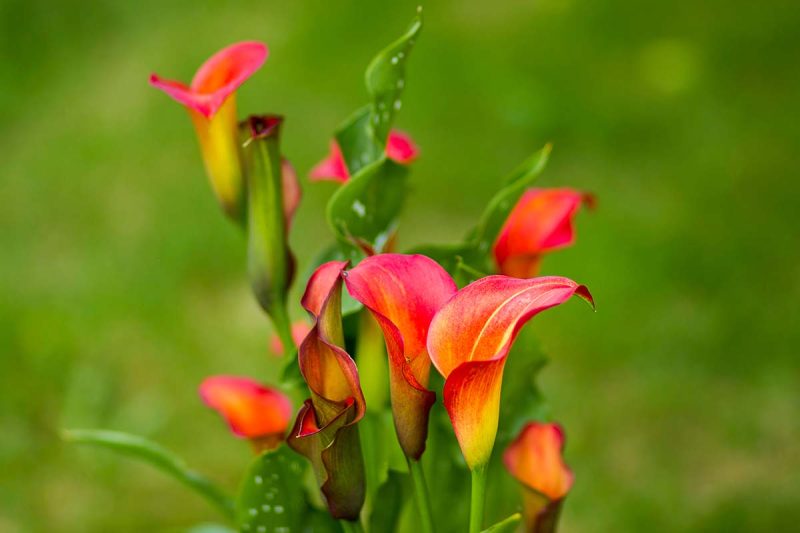Calla lilies are admired worldwide for their elegant trumpet-shaped blooms and glossy, arrow-shaped leaves. Their stunning flowers add a touch of sophistication to any garden or floral arrangement. Yet, many gardeners face a frustrating problem: their calla lilies grow healthy foliage but refuse to bloom.
If you find yourself wondering why your calla lilies are not blooming, this article will explore the common causes behind this issue and guide you through practical steps to encourage your plants to flower beautifully—and quickly.
Understanding Calla Lilies and Their Blooming Cycle

Before delving into reasons why calla lilies may not bloom, it helps to understand their natural growth and flowering cycle. Calla lilies (Zantedeschia spp.) are perennial plants native to southern Africa. They thrive in warm, moist environments and typically bloom during late spring to summer. The blooming process depends on several factors, including light, temperature, soil conditions, and plant maturity.
Unlike some flowers that bloom readily every season, calla lilies require optimal care and environmental cues to produce their characteristic blooms. Healthy green leaves can sometimes mislead gardeners into thinking their plants are thriving, but without the right conditions, flowers may never appear.
Common Reasons Why Calla Lilies Fail to Bloom
Insufficient Sunlight
One of the primary reasons calla lilies do not bloom is a lack of adequate sunlight. These plants require bright, indirect light to initiate and sustain flowering. When calla lilies receive too little sun, they may focus energy on leaf growth rather than producing blooms. Shady locations or indoor spots with weak light can significantly reduce flower production.
In particular, calla lilies grown in full shade often develop lush, green foliage but no flowers. While they tolerate some shade, it is crucial to ensure they get at least 4 to 6 hours of indirect sunlight daily for healthy blooming.
Improper Temperature Conditions
Temperature plays a vital role in the flowering of calla lilies. These plants prefer moderate to warm temperatures between 60°F to 75°F (15°C to 24°C). Exposure to cold temperatures below 50°F (10°C) can cause stress and delay or prevent blooming. Conversely, excessively hot weather above 85°F (29°C) may also inhibit flower development.
Gardeners in cooler climates may notice their calla lilies growing well but not flowering if temperatures remain too low during the growing season. Similarly, if the plants are kept indoors in a drafty or overly cool spot, blooms may fail to appear.
Overfertilization and Nutrient Imbalance
Fertilization is essential to feed calla lilies and support healthy growth. However, an excess of nitrogen-rich fertilizer encourages leafy growth at the expense of flowers. Nitrogen promotes the development of lush green foliage but can inhibit the plant’s natural flowering cycle.
If you notice your calla lilies producing large leaves but no blooms, overfertilization may be the culprit. Using a balanced fertilizer with the right ratio of phosphorus (which supports blooming) and potassium can help shift the plant’s energy toward flower production.
Incorrect Watering Practices
Calla lilies need consistent moisture to grow, but improper watering can stress the plant and hinder blooming. Both overwatering and underwatering cause problems. Overwatering may lead to root rot, depriving the plant of nutrients necessary for flowers. On the other hand, underwatering creates drought stress, causing the plant to conserve energy rather than flower.
Maintaining evenly moist soil without waterlogging is essential. If the soil stays soggy for long periods, roots suffer, and buds may fail to develop.
Immature or Overcrowded Plants
Sometimes the issue is related to the age or crowding of the calla lilies. Young or newly planted calla bulbs may need a season or two to mature before they start blooming. Patience is required, as forcing blooms too early may be unsuccessful.
Additionally, when calla lilies are overcrowded, the competition for nutrients, water, and light increases. Overcrowded plants often focus energy on survival and leaf production rather than flowering. Dividing bulbs every few years can rejuvenate plants and promote better blooms.
Dormancy Period Not Respected
Calla lilies naturally go through a dormancy period, usually in late fall or winter. During this time, foliage dies back and the plant rests underground as a bulb. Failing to allow the plant adequate dormancy can disrupt its flowering cycle.
If calla lilies are kept actively growing without a rest period, they may become exhausted and fail to produce flowers the following season. Providing a proper dormancy phase with cooler, drier conditions is necessary for flower buds to develop later.
How to Fix Calla Lilies That Are Not Blooming Quickly
Improve Light Exposure
To encourage calla lilies to bloom, start by evaluating their light conditions. Move the plants to a brighter location where they receive at least 4 to 6 hours of indirect sunlight daily. For outdoor plants, placing them in spots that receive morning sun and afternoon shade works well.
If growing indoors, placing calla lilies near a bright east or west-facing window can help. Avoid direct harsh midday sun, which can scorch the leaves, but ensure the plants are not sitting in dark corners or under heavy shade.
Regulate Temperature
Maintaining an optimal temperature range is crucial for calla lily blooms. If growing indoors, keep the plants away from cold drafts, air conditioners, or heaters that cause temperature fluctuations. Aim for consistent warmth around 65°F to 75°F (18°C to 24°C).
For outdoor gardens in cooler climates, planting calla lilies in pots allows moving them indoors during cold spells. Conversely, in very hot areas, providing afternoon shade helps protect flowers from heat stress.
Adjust Fertilizer Use
Switch to a fertilizer formula that promotes flowering rather than leafy growth. Fertilizers with higher phosphorus and potassium content support flower development. Feeding the plants every 4 to 6 weeks during the growing season can replenish nutrients without causing excess foliage.
Avoid using high-nitrogen fertilizers or applying fertilizer too frequently. Organic options like bone meal or balanced slow-release fertilizers can provide nutrients more gently.
Optimize Watering Routine
Establish a watering schedule that keeps the soil moist but not soggy. Check the soil regularly by inserting your finger about an inch deep—water when the topsoil feels dry. Using pots with drainage holes prevents water accumulation.
In case of overwatering symptoms such as yellowing leaves or mushy stems, reduce watering and improve drainage. If underwatering signs appear, increase watering frequency, especially during hot weather.
Divide and Replant Overcrowded Bulbs
If your calla lilies have been growing for several years in one area, overcrowding might be an issue. Dig up the bulbs during their dormant period and separate them carefully. Replant the bulbs with adequate spacing, approximately 12 to 18 inches apart.
This practice not only reduces competition but also revitalizes the plants, encouraging more abundant blooming in the following seasons.
Respect Dormancy and Rest Periods
Allow your calla lilies to enter their natural dormancy by reducing watering and stopping fertilization in late fall. When foliage starts to yellow and die back, trim it and keep the bulbs in a cool, dry place if planted in containers.
For bulbs in the ground, mulch the area to protect them during winter. In early spring, resume watering and feeding to signal the plant to start growing again. Proper dormancy helps the bulbs store energy for robust flower production.
Additional Tips to Enhance Calla Lily Blooming
Soil Quality and Drainage
Calla lilies prefer well-draining, rich soil with organic matter. Heavy clay or poorly drained soils can suffocate roots and prevent blooming. Amending soil with compost or peat moss improves texture and fertility.
Raised beds or container planting are excellent options for ensuring good drainage. Healthy roots lead to vigorous flowers.
Pest and Disease Management
While pests rarely cause a total lack of blooms, infestations of aphids, spider mites, or fungal diseases can weaken plants and impact flowering. Inspect leaves regularly for signs of pests or disease.
Treat affected plants promptly with appropriate insecticides or fungicides, or opt for organic solutions such as neem oil. Keeping plants healthy reduces stress and encourages blooming.
Use of Growth Regulators
For advanced gardeners, certain plant growth regulators and bloom enhancers may stimulate flower production. However, these should be used cautiously and according to manufacturer guidelines.
Sometimes, simply adjusting environmental factors is enough to coax blooms without chemical aids.
When to Expect Calla Lilies to Bloom After Fixes
Once you make the necessary adjustments—better light, proper watering, balanced fertilization, and respecting dormancy—you can expect to see flower buds forming within weeks to a couple of months depending on the season. Calla lilies generally take several weeks after dormancy ends to produce their distinctive blooms.
Patience is important, as forcing flowering too early may harm the plant. Consistent care and optimal conditions will reward you with beautiful flowers in due time.
FAQs About Why Are My Calla Lilies Not Blooming
Why are my calla lilies growing leaves but no flowers?
Calla lilies often grow lush foliage if conditions favor leaf growth but lack certain factors like adequate sunlight, proper temperature, or balanced fertilization needed for blooming. Ensuring these elements can trigger flower production.
How much sunlight do calla lilies need to bloom?
Calla lilies require around 4 to 6 hours of bright, indirect sunlight daily. Too little light causes them to focus energy on leaf growth rather than producing flowers.
Can overwatering prevent calla lilies from blooming?
Yes, overwatering can lead to root rot, which stresses the plant and inhibits blooming. Keeping the soil moist but well-drained is important for healthy flowers.
When should I fertilize calla lilies for best blooms?
It’s best to fertilize calla lilies every 4 to 6 weeks during the growing season with a balanced fertilizer that has enough phosphorus to promote flowering, avoiding excess nitrogen.
Do calla lilies need a dormant period to bloom?
Yes, calla lilies require a rest period in late fall or winter, where watering and fertilization are reduced, allowing bulbs to store energy for blooming in the next season.
Conclusion
Calla lilies are stunning plants that can elevate any garden with their graceful flowers. However, when they fail to bloom, it is often due to environmental or cultural factors such as insufficient light, improper watering, temperature stress, or nutrient imbalance. By understanding these common causes and applying targeted fixes, gardeners can quickly encourage their calla lilies to flower.
Improving sunlight exposure, regulating temperature, adjusting fertilization, and allowing proper dormancy are key steps in restoring blooming. With attentive care and patience, your calla lilies will soon transform from leafy greens to elegant flowering beauties, brightening your garden and home.






